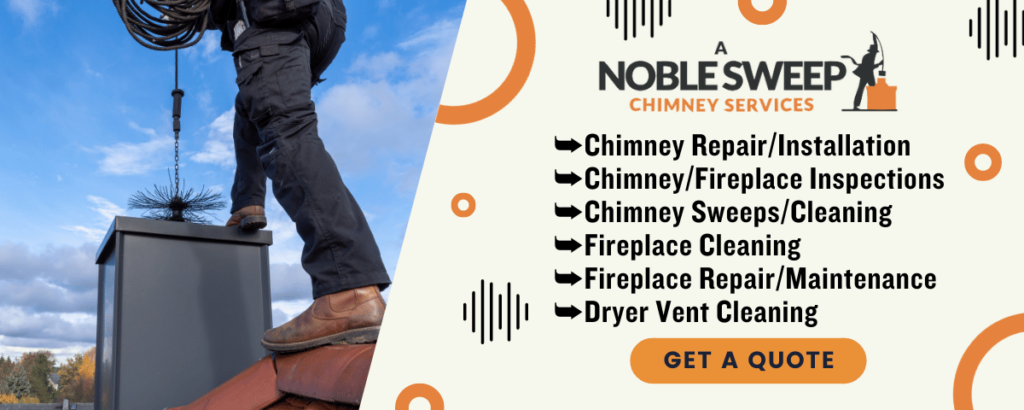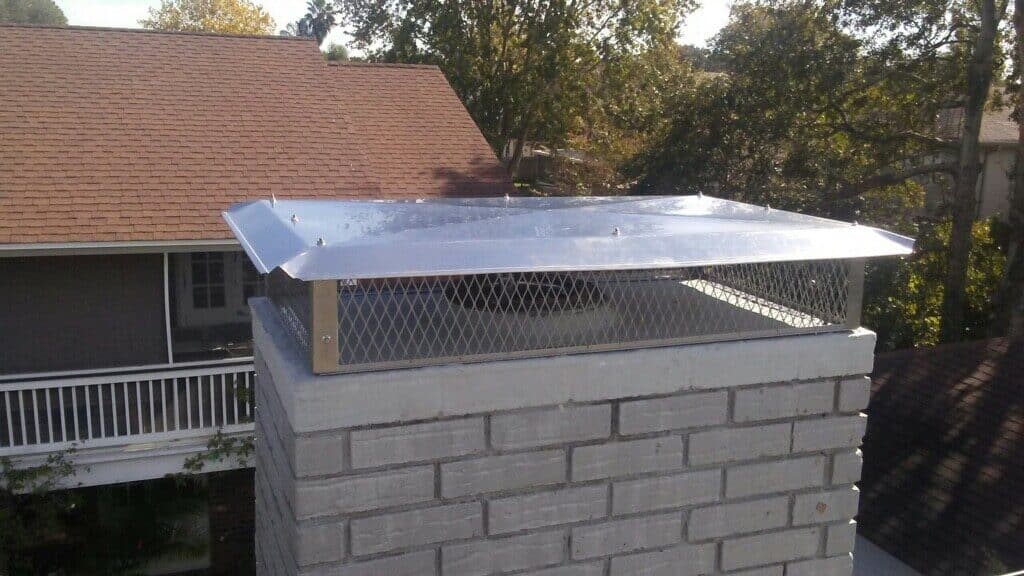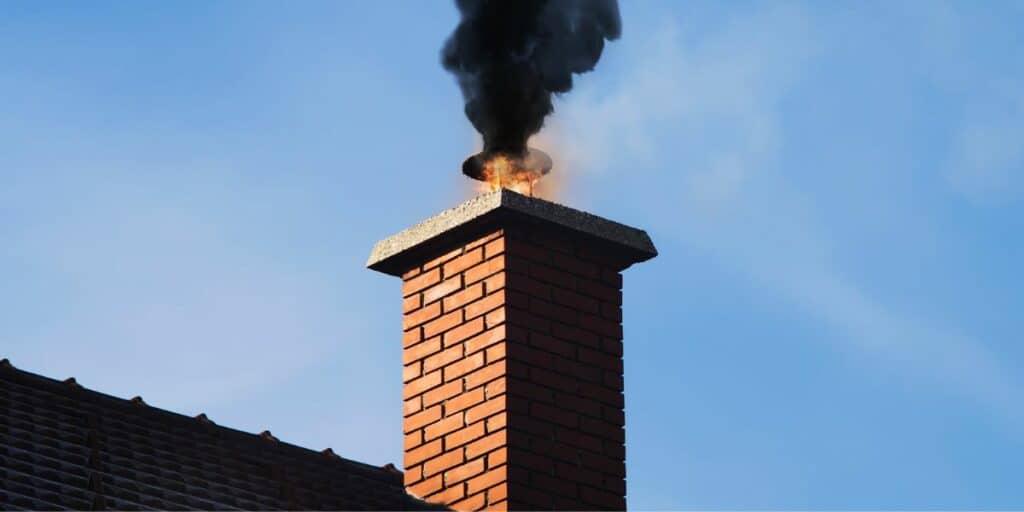How to Prevent Chimney Fires and Protect Your Home
Chimney fires are no joke. According to the latest statistics provided by The Chimney Safety Institute of America (CSIA), approximately 25,000 chimney fires occur every year in the United States. In addition to the lives lost, these fires caused over $125 million in property damage.
Most homeowners are unaware of the risks of chimney fires and how they can be prevented. This article aims to help people understand the dangers of chimney fires, what causes them, how to know when they occur, and what to do about them.
What is a chimney fire?
A chimney fire occurs when residues, such as soot or creosote, are burned on the inside surfaces of stove pipes, flue liners, and chimney tiles.
Chimney fires can cause extensive damage inside chimneys. Many fires start small, burn briefly, and then go out by themselves. No matter how long or large the fire is, it can start a damaging cycle that needs to be addressed sooner rather than later.
Types of chimney fires
There are two types of chimney fires. Both kinds are very dangerous, but the slow-burning ones can often be more so because they are less obvious.
Fast burning
Fast-burning fires are often very conspicuous. Home occupants will surely notice the flames coming out of the chimney. The fire produces a sound that is compared to jet aircraft, so your neighbors or people walking around your house may be alarmed by the noise produced from this fire.
Slow burning
Slow-burning fires are very dangerous because the areas where they occur do not vent freely, allowing the fire to become extremely hot. Chimney fires can burn at 2000 degrees Fahrenheit. At these temperatures, a lot of damage can be done to the property and to the people inside the property.

What are the signs of a chimney fire?
As previously mentioned, chimney fires can be fast-burning or slow-burning. Fast-burning fires in chimneys are very obvious because they consume flammable residue inside the chimney flue.
The signs of a chimney fire include:
- A loud crackling, popping or rattling noise coming from the chimney flue
- The smoke coming into the fireplace or out of the top of the chimney is thick and dense
- The top of the chimney is filled with flames or things that are on fire (pieces of flaming creosote)
- A smell that is strong and intensely hot
- A roaring sound, like that of a freight train or airplane
What causes chimney fires?
Two leading causes of chimney fires are creosote buildup and blocked flues.
Creosote buildup
Creosote is a residue created by condensation as the combustion products exit the wood stove or fireplace and flow into a relatively cooler chimney. With each fire in your fireplace, creosote accumulates. The heat from the burning layers can cause the fire to spread into your home.
Blocked flues
A blocked chimney flue can cause chimney fires, smoke in your room, and dangerous carbon monoxide leaks into your home. Animal nests, creosote or damaged liners can block chimney flues. A professional chimney sweep can check for signs of a clogged flue. They will also ensure that you have chimney caps in place to prevent moisture from entering and animals from getting into the chimney.
How to prevent a chimney fire?
Chimney fires can be hard to detect and extremely dangerous. That’s why it is best to take the steps necessary to prevent them from happening.
Minimize creosote build-up
Creosote is the main cause of chimney fires. This dark brown, highly flammable substance forms on chimney walls as by-products (smoke and vapor) of fire condense when they are moved from the hot wood stove or fireplace into the chimney. The creosote may catch fire if the temperature inside the chimney flue is high and the buildup of creosote is thick.
For a minimum creosote accumulation, burn only hardwoods seasoned for at least 6 months. They should also contain less than 20% moisture, which can be easily tested with a wood humidity meter. These meters are available online or at hardware stores and cost $30 to $100. Remember to keep the damper open (the metal plate that controls the draft in the chimney) during the fire. This will ensure adequate airflow.
If your flue liner (the layer that sits between the chimney and the flue) is not insulated, it’s best to wrap it in a heat-resistant insulation blanket or pour an insulation mixture like vermiculite, which can be purchased at most hardware stores and online for around $10. An insulated flue liner will keep the temperature of your flue from becoming too cold, which could cause fire byproducts to form creosote.
Schedule an annual chimney inspection
A certified chimney sweep should inspect your fireplace, wood stove, and venting system at least once a year. Many defects can lead to chimney fires. This professional will tell you about any damage and, if necessary, fix it. They can also remove obstructions like bird nests, soot, or creosote.
Keep the walls of your chimney clean
You know it’s time to clean your chimney if you find that when you scratch with your finger on the fireplace wall, there is an eighth of an inch buildup (or more). A professional chimney cleaning includes a thorough sweep of the chimney’s exterior, the smoke shelf, the smoke chamber above fireboxes, and the flue and the flue lining. A wide brush can be used by DIYers willing to climb a ladder and clean their chimneys without the help of professionals.

Install a chimney cap
When embers are blown out of a fire, they can ignite leaves and animal nests in a flue. The chimney cap will also keep out critters and debris. The cap also prevents “back puffing,” which is when smoke that has escaped from a fire enters the chimney and then into the house. The caps also stop acidic rainwater from entering the chimney and corroding it. Spend anywhere between $50 and $500 for decorative metal caps. Self-installation of a chimney cap may void your warranty. It may be better to hire a professional.
Use safe fire starters
When choosing fuel, kindling, and tinder, always select the best.
Only use CSIA-approved wood logs or well-seasoned hardwood in your fireplace. Never use gasoline and kerosene as they are highly flammable liquids that can ignite a fire. Don’t use coal in your wood stove unless it’s coal-burning stove. It can raise the temperature and increase the risk of a fire.
Stick to dried branches or twigs for kindling. Cloth produces a lot of smoke when burned. You can use old newspapers or pine cones that have been crumpled or torn. Never use glossy or cardboard paper as tinder. Both contain chemicals that can release toxins when burning.
Use clean burning techniques
Slow-burning, low-temperature fires, especially those left unattended overnight, produce more smoke and leave more combustible materials behind. When creosote hardens on the walls of the chimney, there is an increased fire risk. Fast-burning, hot fires leave less smoke and vapor behind. They also burn wood more efficiently, so little or no creosote is formed.
Use the top-down method to create a clean, efficient fire. Place large logs vertically in the bottom of your fireplace or wood stove, with the bottoms facing you. Add four to five layers of horizontal kindling and then top it off with tinder.
Before retiring for the evening, extinguish your fire. Spread the wood and embers out with a fireplace spatula, then cover the entire area with the ash at the bottom. Douse the wood and embers that have cooled with baking soda until completely covered. The sodium bicarbonate in the baking soda will extinguish all remaining embers. The ashes should be shoveled into a metal container after the firebox has cooled (for at least three hours but ideally eight). Fill the metal container up with water, and keep it out of the house, away from any other flammable material, until you are ready to dispose of it.
Will a chimney fire burn itself out?
Though it is possible that your chimney fire could burn itself out, It is not safe to assume so. A much better plan is to call 9-1-1 immediately after noticing you have a chimney fire.
A chimney fire can spread to other parts of your home and risk the lives of your loved ones inside. At the very least, it can damage the internal exhaust system of your chimney.
What to do if you have a chimney fire?
We’ve already mentioned that it is important to call 9-1-1 in the event of a chimney fire. According to the Chimney Fire Safety Institute of America, “slow-burning fireplace fires are not as dramatic as those that burn more quickly, and often they go undetected until they’re discovered during a subsequent chimney inspection. However, they can still cause significant damage to your chimney and other combustible areas of your home.”

How to put out a chimney fire
Hopefully, you never have the unfortunate situation of a chimney fire in your home. However, you must be prepared should the unthinkable occur.
Although we always recommend vacating the property immediately and calling 9-1-1, here are the steps to extinguish a chimney fire.
Close inlet valves and hatches
If you find a fire, you must shut all valves and hatches of the chimney. You can close the damper if there is no fire in the fireplace at the time. DO NOT close the damper if there is fire in the fireplace. This would cause all of the smoke to be released into the room.
Stop it from spreading
If the chimney flue passes through the floor, it may contact flammable materials and timbers, which can catch on fire if there is a flue fire. You should be on the lookout for smoke in these areas, and don’t forget to check your lofts and basements. You can use water or fire extinguishers to try to put out a fire that is spreading between two floors.
Putting out a chimney fire
Leave the task of putting out an open chimney fire to the firefighters. Call the emergency services. While you wait, if you’re in a cabin or the nearest fire department can’t get to you fast, you may be able to use a powder fire extinguisher to try and control the fire. Open the soot door at the bottom chimney. Aim the extinguisher’s nozzle in the chimney. Release only a small amount by pressing the trigger. Close the door once more. If the fire returns, repeat this procedure.
Get out in time
Remember never to put yourself in harm’s way. Always get out of the house before it becomes unsafe to stay inside.
Final Thoughts
Now you know how to prevent chimney fires and, more importantly, avoid them altogether. Remember, a clean, well-maintained chimney flue won’t catch fire. That’s because they do not have layers of creosote or soot inside them to ignite, and they do not have cracks or damage through which fire or heat can escape the flue. Be sure your chimney is cleaned by a professional sweep every year before you use it, and keep it in good repair!
